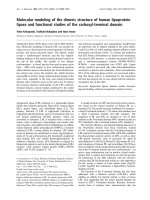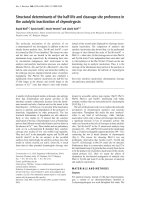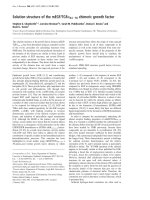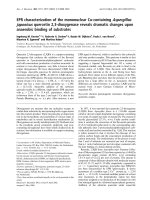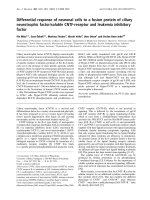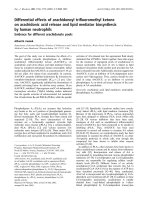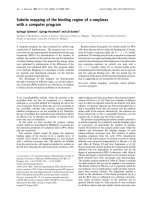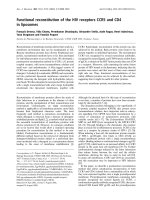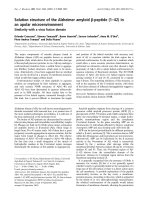Báo cáo Y học: Differential regulation of the Fe-hydrogenase during anaerobic adaptation in the green alga Chlamydomonas reinhardtii pot
Bạn đang xem bản rút gọn của tài liệu. Xem và tải ngay bản đầy đủ của tài liệu tại đây (720.97 KB, 11 trang )
Differential regulation of the Fe-hydrogenase during anaerobic
adaptation in the green alga
Chlamydomonas reinhardtii
Thomas Happe and Annette Kaminski
Botanisches Institut der Universita
¨
t Bonn, Germany
Chlamydomonas reinhardtii, a unicellular green alga, co n-
tains a hydrogenase enzyme, which is induced by anaer-
obic adaptation of the cells. Using the suppression
subtractive hybridizatio n (SSH) approach, the d ifferential
expression of genes under anaerobiosis was analyzed.
A PCR f ragment with similarity t o the genes of ba cterial
Fe-hydrogenases was isolated and used to screen an
anaerobic c DNA expression librar y of C. reinhardtii.The
cDNA sequence of hydA contains a 1494-bp ORF
encoding a protein with an apparent molecular mass of
53.1 kDa. The t ranscription of the hydrogenase gene is
very rapidly induced during anaerobic adaptation of the
cells. The deduced amino-acid sequence corresponds
to two polypeptide sequences determined by sequence
analysis of the isolated native p rotein. T he Fe-hydrogenase
contains a short transit peptide o f 56 a mino acids, which
routes the hydrogenase to the chloroplast stroma. The
isolated protein belongs to a new class of Fe-hydrogenases.
All four cysteine residues and 12 other a mino acids, which
are s trictly c onserved i n t he active site (H-cluster) of
Fe-hydrogenases, have been identified. The N-terminus of
the C. reinhardtii protein is markedly truncated compared
to other no nalgal Fe-hydrogenases. Further conserved
cysteines that c oordinate additional F e–S-cluster i n other
Fe-hydrogenases are missing. Ferredoxin PetF, the natural
electron donor, links the hydrogenase from C. reinhardtii
to the photosynthetic electron transport chain. The
hydrogenase enables the survival of the green algae under
anaerobic conditions by transferring the electrons from
reducing equivalents to the enzyme.
Keywords: anaerobic adaptation; Chlamydomonas rein-
hardtii; Fe-hydrogenase; hydrogen evolution; suppression
subtractive hybridization.
Green a lgae respond to anaerobic stress by s witching the
oxidative pathway to a fermentative metabolism. The
fermentation of organic compounds is associated with
hydrogen evolution. The key enzyme hydrogenase, which is
synthesized only after an anaerobic adaptation, catalyzes
the reversible reduction of protons to molecular hydrogen.
Hydrogenases are found in nearly all taxonomic groups
of pr okaryotes [1,2] and some unicellular eukaryotic
organisms [3,4]. With respect to the m etal composition in
the active center, hydrogenases are divided into three
classes: NiFe-hydrogenases [5,6], Fe-hydrogenases [7], and
the hydrogenases without nickel and iron atoms, which were
found only in archaea [8,9].
Fe-hydrogenases are characterized in h ydrogen-produc-
ing anaerobic microorganisms and protozoa [3,10–13]. They
are known for their CO sensitivity and an enzyme activity
that is 100-fold higher than the activity of the NiFe-
hydrogenases. Recently, the three-dimensional structures of
the Fe-hydrogenases from Clostridium pasteurianum [14] and
Desulfovibrio desulfuricans [15] were published. They have a
multidomain s tructure with numerous [Fe–S] clusters [16]
including a novel type of [Fe–S] cluster (H-cluster) within the
catalytic site. This H-cluster consists of a conventional
[4Fe)4S] c luster bridged by the sulfur atom of a cysteine
residue to a unique binuclear iron subcluster [17].
Fe-hydrogenases from green algae m ediate a light driven
hydrogen evolution after an anaerobic adaptation [ 4], but
this H
2
-production does not occur under photosynthetic
O
2
-evolving conditions [18,19]. The electrons can be
supplied b y m etabolic oxidation of organic compounds
with the release of carbon d ioxide [20,21]. This light
dependent electron transport is 3-(3,4-dichlorophenyl)-1,1-
dimethylurea (D CMU)-insensitive and requires only pho-
tosystem I activity [22]. The role of the hydrogenase in green
algae growing under photosynthetic co nditions in the
natural environment has been unclear for a long time.
Recently it was shown that s ulfur d eprivation in C. rein-
hardtii cultures caused anaerobic conditions and, as a
consequence, hydrogen production [23,24]. Under an
anaerobic atmosphere, the hydrogen metabolism is t he only
pathway for the algae to create enough ATP, which is
required for the survival under this s tress condition [25].
Correspondence to T. Happe, Botanisches Institut der Universita
¨
t
Bonn, Karlrobert-Kreiten-Strasse 13, 53115 Bonn, Germany
Fax: + 49 228 731697,
E-mail:
Abbreviations: DCMU, 3-(3,4-dichlorophenyl)-1,1-dimethylurea;
DBMIB, 2,5-dibromo-3-methyl-6-isopropyl-p-benzochinon; SSH,
suppression subtractive hybridization; TAP, Tris a cetate p hosphate;
DIG, digoxygenin.
Definitions: PS indicates photosystem I and II includ ing the reaction
centers P
700
and P
680
; Q and Z are the prim ary electron acceptors of the
PS II or PS I, respectively; PQ refers to the plastoquinone pool.
Note: the authors would like to d edicate this paper to Herbert Bo
¨
hme,
who has retired because of a malignant disease.
Note: the nucleotide sequ ence re port ed in this paper has be en
submitted to the Gen Bank/EB I Data Bank w ith accession
number CRE012098.
(Received 18 June 2 001, revised 17 December 2001, accepted
18 December 2001)
Eur. J. Biochem. 269, 1022–1032 (2002) Ó FEBS 2002
The Fe-hydrogenase of C. reinhardtii was purified to
homogeneity and biochemically characterized [4]. The
monomeric enzyme of 48 kDa is only synthesized after
anaerobic adaptation and is located in the chloroplast
stroma [26].
Despite the great interest in b iological H
2
evolution i n
green algae, all attempts to isolate the hydrogenase gene
from C. reinhardtii h ave so far not been successful. With
the suppression subtractive hybridization (SSH) technique,
a DNA fragment was isolated that showed similarity to
Fe-hydrogenases. The full-length cDNA clone encoding
HydA was obtained by screening a kgt11 expression library.
This gene bank was constructed with poly(A)
+
RNA
from anaerobically adapted C. reinhardtii cells. T he differ-
ential regulation of protein biosynthesis dur ing a naerobic
adaptation is discussed based on Northern blot analysis.
The results present fundamental data for studying the
hydrogen metabolism in photosynthetic eukaryotes. On
the b asis of this research, we have r ecently published the
isolation and characterization of the hydA gene from
the green alga Scenedesmus obliquus [27].
MATERIALS AND METHODS
Algae strains, culture conditions and anaerobic
adaptation
Wild-type Chlamydomonas reinhardtii 137c(mt+) strain
was originally obtained from the Chlamydomonas Culture
Collection at Duke University. The strain was grown
photoheterotrophically [28] in batch cultures at 25 °C under
a continuous irradiance of 150 lmol photonsÆ(m
2
Æs)
)1
.
Cultures containing TAP ( Tris acetate phosphate) m edium
were flushed vigorously with air containing 5% CO
2
. Cells
were harvested by centrifugation (8 min, 5000 g) in the mid-
exponential growth stage (1–2 · 10
6
cellsÆmL
)1
). The pellet
was resuspended in 0.02 vol. of fresh TAP medium and th e
algae were a naerobically adapted b y flushing the s olution
withargoninthedark.
Hydrogen evolution assay
Hydrogenase activity of C. reinhardtii was determined
in vitro with reduced methyl viologen using a gas chro-
matograph (Hewlett Packard 5890 A Series II, column:
molecular Sieve 5 A
˚
, Mesh 60/80). The assay, containing in
a final volume of 2 mL Pipes pH 6.8 (20 m
M
), Na
2
S
2
O
4
(20 m
M
), methyl viologen (5 m
M
), was incubated a naero-
bically at 25 °C for 20 min. One unit is defined as the
amount of hydrogenase evolving 1 lmol H
2
Æmin
)1
.
Purification of the Fe-hydrogenase and amino-acid
sequence
Cells from a 40-L culture of C. reinhardtii were harvested by
ultra fi ltration through an Amicon U ltrafiltration S ystem
DC 10 LA, equipped with a hollow-fiber filter. The pellet
was resuspended in 200 mL TAP medium. After anaero bic
adaptation by flushing the solution with argon for 1 h in th e
dark, all steps were performed under strictly anaerobic
conditions [4]. The isolated Fe-hydrogenase was chemically
cleaved by cyanogen bromide (CNBr). After separation of
the CNBr f ragments on an SDS polyacrylamide gel, f our
peptides were blotted onto a poly(vinylidene d ifluoride)
membrane and were sequenced. Automated Edman degra-
dation was performed with an Applied B iosystem model
477 A sequencer with online analysator model 120 A.
RNA blot hybridization
Total nucleic acids were isolated from algae grown under
aerobic conditions and after anaerobic adaptation accord-
ing to Johanningmeier & Howell [29]. Poly(A)
+
RNA was
isolated using the RNA Kit (Qiagen); 10 lgtotalRNAor
0.5 lgpoly(A)
+
RNA were separated on each lane of 1.2%
agarose gels in formaldehyde [30]. The RNA was trans-
ferred to nylon membranes (Hybond
+
, Amersham) and
hybridized with RNA probes, which were labeled with
digoxygenin (DIG)-dUT P by in vitro transcription. Tran-
scripts of the hydA gene were detected using a 1.0-kb SmaI
cDNA fragment (Fig. 1). A DIG-dUTP labeled cDNA,
which encodes the malate dehydrogenase, was used as
control for a constitutive expressed gene.
Suppression subtractive hybridization (SSH)
SSH was performed with the Clontech PCR-select
TM
cDNA Subtraction Kit (Clontech Lab oratories Enc., Palo
Alto, CA, USA) according to t he manufacturer’s recom-
mendations, except for modifications of the PCR and
hybridization conditions. The mRNA was isolated from
aerobically grown cells (driver) and from anaerobically
adapted algae ( tester). The driver and t ester cDNAs w ere
denatured separately for the first hybridization at 100 °Cfor
30 s and then incubated for 10 h at 68 °C. For the second
hybridization, driver cDNA was denatured at 100 °Cfor
30 s, then directly added to the pooled mix of the previous
hybridization, and incubated at 68 °C for 20 h. Primary and
secondary P CR con ditions were altered to increase the
specificity o f t he amplification. The P CR conditions with
subtracted cDNA were as follows: 25 cycles each 94 °Cfor
30 s, 68 °C for 30 s, and 72 °C for 1 min. The subtracted
cDNA was s ubjected to a second round of nested PCR,
Fig. 1. Sc hematic map of the cDNA and the genomic DNA region of
hydA from C. reinhardtii. (A) Structural features of the hydA cDNA.
Coding regions are marked as large arrows with the transit peptide
shown in black. Lines indicate 5¢ and 3¢ URTs. (B) The mosaic
structure of hydA is illustrated by gray (exons) and white boxes
(introns). The RNA and DNA probes that were used for blotting
experiments are no ted.
Ó FEBS 2002 Fe-hydrogenase from Chlamydomonas reinhardtii (Eur. J. Biochem. 269) 1023
using the same PCR conditions with a decreased number
of 15 cycles. Specific primers were used for the identifi cation
of the amplified hydA cDNA fragment. From the
N-terminal amino-acid sequence a degenerate oligonucleo-
tide Hyd5 [5¢-GCCGCCCC(GC )GC(GCT)GC(GCT)GA
(AG)GC-3¢] was synthesized, t aking into account known
C. reinhardtii amino-acid sequences. The second primer
Hyd2 (5¢-CCAACCAGGGCAGCAGCTGGTGAA-3¢)
was deduced from the conservative amino-acid sequence
motif of Fe-hydrogenases FTNaCl/CitPC.
PCR was performed using either Hyd5 or Hyd2 and the
nested PCR primer 2R from the Clontech Subtraction Kit.
The PCR conditions were as follows: 20 pmolÆmL
)1
of each
primer were used; 35 cycles (denaturing at 95 °Cfor40s,
annealing at 54 °C for 1 min, and extension at 72 °Cfor
1 m in). The amplified cDNA fragments were cloned i nto
the T overhang vector pGEMÒ-T Easy (Promega).
Screening of the cDNA library, cloning and sequencing
A cDNA library was constructed u sing the Stratagene ZAP
Express cDNA synthesis Kit (Stratagene, La Jolla, CA,
USA) with 5 lg mRNA of anaerobically adapted cells
of C. reinhardtii. Double-stranded cDNA was ligated into
the ZAP Express vector, packaged with the Gigapack
Gold Kit, and transfected into Escherichia coli XL Blue
MRF
–
cells. The primary recombinant library con tained
5 · 10
6
recombinant phages and was amplified according to
the manufacturer’s instructions.
A 366-bp PCR fragment was radiolabeled with
[a-
32
P]dCTP using the random-primer m ethod [31].
Approximately 5 · 10
5
plaques were analyzed under strin-
gent hybridization conditions, resulting in 20 positive
signals. The pBK-CMV phagemid vector with the different
cDNAs was excised and used as a template for PCR, which
was performed by using Hyd2 and Hyd5 primers at an
annealing temperature of 56 °C for 1 min. Four plasmids
contained cDNA fragments that showed similarities to the
366-bp fragment. All cDNA fragments were partially
sequenced, and the largest clone pAK60 was completely
sequenced. Sequencing was carried out by the dideoxy
nucleotide triphosphate chain-termination method using the
T
7
sequencing Kit (Pharmacia Biotech). Both strands of
genomic and cDNA of hydA were completely sequenced
using a nested set o f unidirectional deletions [32] or hydA
specific synthetic oligonucleotides. The sequences of the
Fe-hydrogenase are available under accession number
CRE012098.
Primer extension experiments were performed as
described previously [27] using a 22-mer oligonucleotide
(5¢-AATAGGTGGTGCGATGAAGGAG-3¢), which is
complementary to the 5¢ end o f the hydA transcript.
Expression studies in
E. coli
and Western blot analysis
The coding region of hydA was amplified by PCR. The
primers were identical to the cDNA sequences coding
for the N- and the C-terminus of the mature protein plus
several additional bases including NdeIandBamHI restric-
tion sites, respectively (underlined). The oligonucleotide
sequences were: HydNde (5¢-
CATATGGCCGCACCCG
CTGCGGAGGCGCCT-3¢), HydBam (5¢-CC
GGATCC
TCAAGCCTCTGGCGCTCCTCA-3¢).
The hydA gene, corresponding to amino acids 57–497, was
amplified, confi rmed by sequences analysis and cloned into
corresponding sites of the pET9a e xpression v ecto r (Pro-
mega). The constructed p lasmid was then t ransformed into
E. coli strain BL21(DE3). After induction with 1 m
M
isopropyl-thio-b-
D
-galactoside, the cells were resuspended
in lysis buffer. Crude extracts from C. reinhardtii were
isolated by harvesting cells after indicated anaerobic adapta-
tion times. The p ellet was resuspended in s olubilization buffer
and incubated w ith vigorous vortexing at RT for 30 min. The
protein extracts from C. reinhardtii and E. coli were separat -
ed by 12% SDS/PAGE and blotted onto a poly(vinylidene
difluoride) membrane. Affinity-purified antibodies were
diluted 1 : 200 and used for Western blot analyses [26].
Sequence analysis and protein modeling
Nucleic acid and protein s equences were analyzed with the
programs
SCI ED CENTRAL
(Scientific Educational Software,
Durham, NC, USA) and
CLUSTALW
[33]. The
BLAST
server
[34] of the National Center for Biotechnology Information
(Bethseda, MD, USA) was used for database searches.
RESULTS
Isolation of cDNA clones, which are differentially
expressed during anaerobic adaptation
In order to a mplify a p art of the hydrogenase gene in a
PCR reaction, degenerate oligonucleotides corresponding
to conserved regions of known Fe-hydrogenases were used.
All products of expected sizes were cloned and sequenced,
but they showed no homologies to other hydrogenases (data
not shown). Examinations were then focused on the process
of anaerobic adaptation in C. reinhardtii, because the
Fe-hydrogenase was only detected under these conditions
[26]. Therefore, we isolated two different populations of
mRNA and took advantage of the SSH technique [35].
Poly(A)
+
RNA was isolated from aerobically grown
C. reinhardtii cells and from a cell suspension flushed
15 min with argon. After cDNA synthesis, subtractive
hybridization, and PCR experiments (see Material and
methods), the amplified PCR f ragments were cloned and
sequenced. Twenty different clones containing inserts of
184–438 bp were analyzed (Table 1). In transcription ana-
lyses, 15 of them showed an increased signal under anaerobic
conditions (data not shown). Database comparisons (using
GenBank/EBI DataBank) confirmed that eight of these
cDNA fragments are similar to genes encoding proteins of
the cytoplasmic ribosome complex. The sequences of six
clones did not co rrespond to any entries in the databases.
Four of these novel clones showed differences in expression
between aerobically grown and anaerobically adapted c ul-
tures. Another cDNA fragment (No. 7) indicated similarity
to the 5¢ region of the Fe-hydrogenase from bacteria.
Analysis of the hydA cDNA and genomic sequences
A kgt11 cDNA expression library was c onstructed u sing
poly(A)
+
RNA from anaerobically adapted cells (15 min).
Two oligonucleotides were generated on the basis of the
cDNA fragment isolated by SSH and the N-terminal
sequences of the purified hydrogenase. They were used to
1024 T. Happe and A. Kaminski (Eur. J. Biochem. 269) Ó FEBS 2002
amplify a 366-bp cDNA fragment that showed 41%
identity to the corresponding part of the Fe-hydrogenase
of C. pasteurianum. The fragment was labeled with
[a-
32
P]dCTP an d u sed t o s creen the cDNA library. Four
independent cDNA clones with different sizes of 2.4-, 1.9-,
1.7- and 1.6-kb were identified and sequenced. The nucleo-
tide sequence of the largest clone, 2399-bp, revealed an ORF
encoding a polypeptide of 497 amino a cids (Fig. 1). The
cDNA also contained a 5¢ UTR (158-bp) and a longer 3¢
UTR ( 747-bp e xcluding the polyadenylated tail). Charac-
teristic features of other C. reinhardtii cDNA clones, e.g. a
high average G/C content (62.1%) and a putative polyade-
nylation signal (TGTAA, 727-bp downstream of the stop
codon [ 36]) were found. The transcription start position was
confirmed by primer extension 158-bp upstream of the
ATG start codon (Fig. 2).
Approximately 5-kb of the hydA genomic region was
determined. The coding sequence is interrupted by seven
introns (Fig. 1) with sequences at their 5¢ and 3¢ ends
corresponding to the typical splicing sequences from
eukaryotes [37]. T he promoter region does n ot contain a
putative TATA box or any other known transcription
motifs. The sequence data were submitted to the GenBank/
EBI DataBank under accession number CRE012098 three
years ago. M eanwhile parts of the cDNA sequen ce were
determined by another group and deposited under accession
number AF289201.
Southern hybridization experiments were perfor med at
high stringency using a PCR fragment as p robe (Fig. 3).
They showed the presence of one hybridizing signal of
similar intensity in different digestions, suggesting that
HydA is encoded by a single copy gene in the C. reinhardtii
genome. The same hybridization pattern was observed even
under low stringency conditions (hybridization temperature
50 °C; data not shown).
Characterization of the Fe-hydrogenase HydA
The mature polypeptide consists of 441 amino acids with a
calculated molecular mass of 47.5 kDa and a predicted
isoelectric point of 5.6. The N-terminal 56 amino acids
probably function as transit peptide, because they show
characteristics of polypeptides that route proteins into the
chloroplast stroma [38]. The stromal targeting domain i s
probably cleaved by a stromal peptid ase at the conserved
cleavage motive Val-Ala-Cys-Ala (Fig. 2). In addition to the
detection of the protein using antibodies raised against the
Fe-hydrogenase, t he localization o f t he mature protein in
the chloroplast stroma is indicated by a high content of
hydroxylated and basic amino acids in the t ransit peptide
sequence [39].
The deduced amino-acid sequence of the mature HydA
polypeptide from C. reinhardtii shows 60% identity and
71% similarity to the Fe-hydrogenase o f S. obliquus [27],
which was recently isolated on the basis of the data of this
work. Comparisons with NiFe-hydrogenases o f bacteria
(including the photosynthetic cyanobacteria) had obviously
lower scores, e.g. 25% similarity with the NiFe-hydrogenase
(HoxH) of Ralstonia eutropha [1].
A conserved d omain of about 300 amino acids is found in
the C-terminal part of all Fe-hydrogenases. The sequences
are highly conserved, especially in the region that is involved
in the c atalytic mechanism (H-cluster), indicating structural
similarity between Fe-hydrogenases [14]. Four cysteine
residues at positions 114, 169, 361 and 365 might coordinate
the H-cluster in C. reinhardtii. Twelve strictly conserved
amino a cids of HydA proteins p robably define a binding
pocket surrounding the a ctive center as shown by structural
data of C. pasteurianum and D. desulfuricans [14,15]. All of
them are present in the C. reinhardtii protein (Pro37, Ala38,
Thr74, Ala78, Cys113, Pro138, Met167, Lys 172, Glu175,
Phe234, Val240 and Met359; Fig. 4). An interesting inser-
tion of 45 amino acids was only identified at the C-terminus
of the C. reinhardtii polypeptide (position 285–329).
The N-terminal region of the green algae protein is much
shorter and completely different to all known Fe-hydrog-
enases. Amino-acid sequence analyses have indicated t hat
Fe-hydrogenases i n general contain two [4Fe)4S] clusters
(F-cluster) in a ferredoxin-like domain. They might be
involved in the transfer of electrons from the donor to the
catalytic center [15]. This N-terminal domain with the
F-cluster o r o ther conserved cysteines is completely mi ss-
ing i n HydA o f C. reinhardtii. A novel electron transport
pathway i s postulated f rom the exogenous donor (ferred-
oxin) directly to the H-cluster.
Protein sequencing of the enzyme and recombinant
expression of HydA in
E. coli
To verify that the hydA ORF encodes t he Fe-hydrogenase
of C. reinhardtii, the enzyme was purified according to
Happe & Naber [4]. The purified protein was able to evolve
Table 1. Summary of anaerobically induced c DNA clones generated
from Chlamydomonas reinhardtii by suppression subtractive hybridiza-
tion (SSH). –, n ovel s equence . +, on ly or stronger expression in
anaerobically grown cells.
No.
Size
(bp)
a
Gene
b
mRNA
(kb)
c
Differential
expression
d
1 281 Ribosomal protein S8 0.8 +
2 312 – 2.4 +
3 192 – 1.8 –
4 369 Ribosomal protein L17 1.2 +
5 301 Catalase 2.1 –
6 297 – 1.6 +
7 232 Fe-hydrogenase 2.4 +
8 317 Ribosomal protein S8 0.8 +
9 184 Malate-dehydrogenase 1.8 –
10 412 Ribosomal protein S15 0.7 +
11 309 – 2.2 +
12 243 Ribosomal protein L12 0.9 –
13 321 – 1.1 +
14 272 Ribosomal protein S8 0.8 +
15 251 Ribosomal protein L37 0.7 –
16 380 14-3-3 protein 1.5 +
17 438 Enolase 2.0 +
18 384 Aldolase 1.7 +
19 273 Ribosomal protein S18 0.8 +
20 195 – 1.9 +
a
Size of PCR-generated inserts that were determined after
sequencing.
b
Sequence identities based on comparison with
General Bank/EMBL database.
c
Estimation of the size (kb) of
mRNA by Northern analysis.
d
Relative expression levels are based
on Northern analysis with poly(A)
+
RNA.
Ó FEBS 2002 Fe-hydrogenase from Chlamydomonas reinhardtii (Eur. J. Biochem. 269) 1025
hydrogen, w hen incubated with reduced methyl viologen.
After proteolytic digestion with cyanogen bromide, four
bands of 4, 8, 9 and 11 kDa were detected after SDS/PAGE
separation (data not shown). Two fragments (9 and
11 kDa) were sequenced by Edman degradation. They are
identical with the deduced amino-acid sequence of hydA
(sequences are shadowed in gray in Fig. 2). The fragment
corresponding to the cDNA region between 158 and
1636 bp of hydA was NdeI–BamHI cloned into the expres-
sion vector pET9a. The heterologous expressed protein was
Fig. 2. Nuc leotide sequence of the hydA cDNA
and the deduced amino-acid sequence of the
hydrogenase from C. reinhardtii. The sequence
was submitted to the GenBank/EBI Data-
Bank under accession number CRE012098.
An arrow marks the transcription start point.
The ATG start codon and the TGA stop
codonaredrawninboxes.Boldfaceletters
indicate the cDNA sequence. Gray shadows
mark amino acids corresponding to polype p-
tide sequence s that wer e determin ed by
sequencing the N-termin us of the protein.
Black shadows mark the putative transit
peptide, and the unde rlined amino acids ind i-
cate the putative cleavage site for the endo-
peptidase. Boldface double underlined letters
indicate a signal for polyadenylation.
1026 T. Happe and A. Kaminski (Eur. J. Biochem. 269) Ó FEBS 2002
detected using antibodies raised against the Fe-hydrogenase
(Fig. 5). Both the purified Fe-hydrogenase of C. reinhardtii
and the overexpressed enzyme had the same size
( 47.5 kDa). No hydrogenase activity could be measured
within the lysate of the induced E. coli cells. This result is in
agreement with S tokkermans et al. [40] and Voordouw
et al. [41] who also detected no H
2
-production of the
recombinant expressed Fe-hydrogenase from Desulfovibrio
vulgaris in E. coli cells. An explanation might be the
inability of E. coli to assemble the unique active site of the
Fe-hydrogenases. It is known that E. coli has only three
NiFe-hydrogenases with a different maturation s ystem for
the catalytic center [42].
Induction of gene expression during anaerobic
adaptation
In aerobically grown cells, neither hydrogenase activity [4]
nor protein can be identified by immunoblot analysis.
However, HydA can be detected only 15 min after anaer-
obic adaptation (Fig. 6).
The expression of the hydA gene is probably regulated at
the transcriptional level. Total RNA was isolated from cells
that had been anaerobically adapted by flushing with argon
for 0, 15, and 30 min. Northern blot hybridization demon-
strated that the hydA gene is expressed very rapidly after the
beginning of anaerobic adaptation. No transcript could be
detected before adaptation (t ¼ 0), but a significant signal
occurred after just 15 m in of anaerobiosis (Fig. 6). The size
of the transcript (2.4 kb) confirmed t he full-length of the
isolated hydA cDNA fragment.
DISCUSSION
Differentially expressed genes during anaerobic
adaptation
Hydrogen metabolism induced b y anaerobic conditions is
well es tablished in g reen algae. I n the absence of oxygen,
C. reinhardtii, a nd also plants, s witch their metabolism t o
fermentation [43,44]. In the light, algae degrade cellular
starch via g lycolysis [45 ] and hydrog en gas is evolved. It has
been suggested that reducing equivalents from the glycolysis
or the c itric acid c ycle can t ransfer t heir electrons to the
photosynthetic electron transport chain [46]. However, the
molecular principles of the gene induction under anaerobic
conditions in C. reinhardtii are poorly understood.
In this present work, we investigated the patterns of gene
expression in aerobically grown and anaerobically adapted
cells by isolating differentially expressed genes. The SSH
method combines subtractive hybridization with PCR [47]
to generate a population of PCR fragments enriched with
gene sequences that are only expressed under anaerobic
conditions. Compared to other PCR-based cloning strate-
gies, such as differential display [48], the great a dvantage of
SSH is that fewer false positives are generated; 70% of the
cloned fragments represented differentially expressed genes.
Among the 20 sequenced cDNA clones, we found three
DNA fragments encoding the ribosomal S8 protein. Most
of the other sequences (eight of 20) also corresponded
to ribosomal protein sequences. This might indicate that
the transcripts of the ribosomal protein genes (rps, rpl)
accumulate under stress conditions. This is in good agree-
ment with Dumont et al. [49] who found that an accumu-
lation of ribosomal p roteins takes place un der phosphate
starvation. Moreover, two of the identified cDNAs enco de
for proteins (aldolase, enolase), which are induced in other
organisms by anaerobic stress [50,51]. Anaerobic treatment
of maize seedlings alters the profile of total protein synthesis
[52,53]. It is known that the induction of the anaerobic
proteins is the result of a n increased mRNA level. Maize
(Zea mays L.) responds to anaerobic stress by redirect-
ing t he synthetic machinery towards the synthesis of s ome
enzymes involved in glycolysis or sugar-phosphate
metabolism [54].
HydA belongs to a new class of Fe-hydrogenases
HydA of C. reinhardtii, the first isolated gene encoding
a hydrogenase of a photosynthetic eukaryotic cell, repre-
sents a novel type of Fe-hydrogenases. Parts of the
deduced amino-acid sequence of the cDNA correspond to
the polypeptide sequence of the tryptic fragment
(VPAPGSKFEELLKHRAAARA), and the N-terminus
Fig. 3. Southern hybridization analysis of hydASouthern blot analysis.
C. reinhardtii genomic DNA was digested with three different restric-
tion endonucleases (SacI, HincII, PstI) a nd 1 0 lg of DNA was loaded
per lane. The DIG-dUTP labeled DNA fragment (750-bp) was used
for hybridization as indicated in Fig. 1.
Ó FEBS 2002 Fe-hydrogenase from Chlamydomonas reinhardtii (Eur. J. Biochem. 269) 1027
Fig. 4. Mult iple sequence alignments of Fe-hydrogenases. Sequence comparison o f the deduced amino-acid se quence of HydA from C. reinhardtii
with Fe-hydrogenases published for other organisms. The protein a lignment was done by using the Vector NTI p rogram (
INFORMAX
). Black
highlighted letters indicate amino acids identical to th e HydA protein. Gray shadowed amino acids indicate conserved changes o f the amino acids.
The abbreviations of the organisms are: C. r., Chlamydomonas reinhardtii (CRE012098); S. o., Scenedesmus obliquus [27]; M. e., Megasphaera
elsdenii [11]; D. d., Desulfovibrio desulfuricans [15]; C. p., Clostridium p asteuria num [12]; N. o., Nyctotherus ovalis [10]. Black arrows indicate
conserved cyste ines, g ray one s t he residu es tha t are n ec essary for the formation of the H -clu ster an d white a rrows re fer to the conserved cysteine s of
the F-cluster, which is lacking in C. reinhardtii and S. obliquus.
1028 T. Happe and A. Kaminski (Eur. J. Biochem. 269) Ó FEBS 2002
(AAPAAAEAPLSHVQQALAELAKPKD) f rom t he
purified native enzyme [4]. Further evidence that the isolated
cDNA encodes an Fe-hydrogenase is the fact that the
recombinant HydA s pecifically r eacts with the antibodies
raised against the active enzyme. The amino-acid sequence
of HydA shows only c onsiderable similarity to Fe-hydro-
genases but not to NiFe-hydrogenases. The Fe-hydrogenase
family is one c lass of hydrogenases defined by Vignais et al.
[55]. The enzymes have been identified in a small group of
anaerobic microbes, where they often catalyze the reduction
of pr otons with a high specific activity to yield hydrogen
[16]. Interestingly, Fe-hydrogenases were not found in
cyanobacteria, the free-living ancestor of plastids, suggest-
ing a noncyanobacterial origin for the algal hydrogenases.
The important structural features found among the
amino-acid sequences of Fe-hydrogenases are also present
in the C. reinhardtii hydrogenase sequence. A highly
conserved domain of about 130 amino acids was detected
in the C-terminal part of the protein. The designated active-
site domain [14] consists of an atypical [Fe–S] cluster
(H-cluster). In C. pasteurianum, the H -cluster contains six
Fe atoms a rranged as a [4Fe)4S] subcluster br idged to a
[2Fe] s ubcluster by a s ingle cysteinyl sulfur. T he [4Fe 4S]
subcluster is coordinated to the protein by four cysteine
ligands, which have also been found in the amino-acid
sequence of C. reinhardtii (Fig. 4). A number of mostly
hydrophobic amino-acid residues define the environment of
the active site and might have a function in protecting
the H-cluster from solvent access [14]. In contrast to all
Fe-hydrogenases including HydA of S. obliquus,the
enzyme of C. reinhardtii has an interesting additional
protein domain. A small insertion of 45 amino acids
between residue Ser284 and Val330 builds an external loop
of the protein that might b e involved in electrostatic binding
of the natural electron donor ferredoxin (M. Winkler,
B. Neil & T. Happe, unpublished results).
In the N-terminus of other Fe-hydrogenases further
cysteine residues w ere found that bind accessory iron sulfur
clusters. A ferredoxin homologous domain (F-cluster) coor-
dinates two [4Fe)4S] clusters in all non algal Fe-hydrogen-
ases [3,11]. An additional [4Fe)4S] cluster and one [2Fe)2S]
center were de tected within the Fe-hydrogenases of C. paste-
urianum [14]. Based on similarities of the primary sequences,
the same cofactors are proposed for Thermotoga maritima
and Nyctotherus ovalis [10,13]. The F-cluster is responsible
for the electron transfer from t he electron donor (mostly
ferredoxin) to t he active center [56]. It has been suggested that
the proteins containing two [4Fe–4S] clusters a re ancestors of
the Fe-hydrogenases [55].
The N-terminus of the C. reinhardtii and S. obliquus
proteins is strongly reduced, and conserved cysteines were
also not found. Therefore we suggest that all accessory
[Fe–S] clusters are m issing in the a lgal hydrogenases. The
native protein of C. reinhardtii is located in the chloro plast
stroma [26]. T he first 56 amino acids of the u n processed
enzyme probably function as a transit peptide, because they
were not characterized i n t he purified hydrogenase and a
putative peptidase cleavage site (Val-Ala-Cys-Ala) [38,39]
could be detected at the end of this fragment. The natural
electron donor of the hydrogenase in C. reinhardtii is the
ferredoxin (PetF) of the photosynthetic electron transport
pathway [26]. Measuring the H
2
-evolution, we have shown
that the hydrogenase activity is directly linked to the
47.5-kDa subunit [4]. As w e have not found a second
subunit necessary for hydrogenase activity, we suggest that
a direct electron tran sfer from PetF to H ydA takes place.
In vitro, a hydrogen evolution by HydA was only measured
with plant-type [2Fe)2S] ferredoxins such as PetF of
C. reinhardtii, S. obliquus and s pinach as electron mediators
(data not shown).
Fig. 5. Overexpression of hydA in E. coli. The hydA gene corre-
sponding to amino acid 57 to residue 497 was cloned NdeI–BamHI
into th e pET9a vector. The HydA p rotein was overexpressed upon
induction with i sopropyl thio- b-
D
-galactoside . L anes 1, purified
hydrogenase from C. reinhardtii; Lanes 2 , protein extract from 2 -h
induced E. c oli cells was separated on an SDS polyacrylamide gel. The
molecularmassmarker(Bio-Rad)indicatesrelativemolecularmasses
in kDa. (A) The SDS polyacrylamide gel was stained w ith Coomassie
Blue. (B) Western blo tting and imm unodete ction was carrie d out a s
described previously [24].
Fig. 6. D ifferential expression of the hydA gene shown by Northern blot
analysis. The aerobically grown C. reinhardtii cells were c entrif uged,
resuspended in buffer and anaerobically adapted by flushing the
solution with argon. Adapted cells were harvested at 0, 15, 30 and
60 min, and RNA of the cells and proteins were isolated a s d escribed in
Materials and methods. (A) Northern hybridization with the hydA
specific probe. (B) Hybridization with a constitutively expressed gene
(malate dehydrogenase). RNA size standards (Roche) in kb are indi-
cated on t he le ft. (C) Immunoblot w ith a ffinity-purified antibodies on
the right.
Ó FEBS 2002 Fe-hydrogenase from Chlamydomonas reinhardtii (Eur. J. Biochem. 269) 1029
Why do the photosynthetic green algae still keep the
anaerobically induced hydrogenases? The most likely
explanation is that the enzymes ensure t he survival of the
cells under these anaerobic conditions. Melis et al. have
shown that H
2
-evolution is the only mechanism available to
the algae for generating sufficient amounts of ATP under
S-depleted anaerobic conditions [23,24]. It is known that
C. reinhardtii is still able to photoproduce hydrogen when
photosystem II is inhibited by DCMU, but no H
2
-evolu-
tion occurs after an addition of 2,5-dibromo-3-methyl-
6-isopropyl-p-benzochinon (DBMIB; F ig. 7) [27]. Under
anaerobic conditions, accumulated reducing equivalents
from the fermentative metabolism c annot be oxidized via
respiration, as the electron acceptor o xygen is missing. The
NAD(P)H reductase protein complex has r ecently been
isolated from plants [58], a nd inhibitor e xperiments have
shown evidence o f a membrane-bound, chloroplast-located
reductase in C. reinhardtii [59]. The light-dependent electron
transport of the H
2
-evolution is driven by p lastoquinone
and photosystem I. The donor ferredoxin transfers electrons
in a last step to the hydrogenase and molecular hydrogen is
released (Fig. 7).
Regulation of
hydA
at the transcriptional level
Our studies have shown that there is a correlation between
the increase of hydrogen production and the anaerobic
adaptation, which was documented by activity measure-
ments [ 26] and immunoblots (Fig. 6). It i s likely that t he
induction of hydA is regulated on the level of transcription.
We observed t hat the amount of mRNA increased directly
with the measured H
2
-evolution. In C. reinhardtii, a
dramatic change in the hydrogenase transcript level occurs
during the shift from an aerobic to an anaerobic atmo-
sphere, which means that the transcription is regulated
by the oxygen status of the cells. A very rapid increase of
the hydA transcript was detected in the first 3 0 min of
anaerobiosis. This quick increase of gene transcription is
only reported for the cyc6 gene in C. reinhardtii [60] and for
the SAUR (Small Auxin-Up RNA) genes in plants [61].
Interestingly, the hydA gene of S. obliquus is constitutively
transcribed under aerobic conditions [27] indicating another
regulation system for the expression of the hydrogenase. At
the m oment it is not clear if this effect rests upon a new
synthesis or a higher stability o f the hydA mRNA.
As with other nuclear genes, the promoter region of the
hydA from C. reinhardtii contains no conserved TATA box
or other motif similarities [62]. As no defined motif
structures in the promoter region of hydA have been found,
further g enetic analyses are necessary to investigate the
rapid induction of hydA in C. reinhardtii.
ACKNOWLEDGEMENTS
The authors wish to t hank D. Nabe r for he lpful advic e and discussions.
We thank Dr R. Deutzmann (Universita
¨
t Regensburg) for determ ina-
tion of the amino-acid sequences. This work was supported by t he
Deutsche Forschungsgemeinschaft (Ha 2555/1-1).
REFERENCES
1. Friedrich, B. & Schwartz, E. (1993) M olecular biology of hydro-
gen utilization in aerobic chemolithotrophs. Annu. Rev. Microbiol.
47, 351–383.
2. Przybyla,A.E.,Robbins,J.,Menon,N.&PeckJr,H.D.(1992)
Structure–function relationships of nickel-containing hydrogen-
ases. FEMS Microbiol. Rev. 88, 109–136.
3. Bui, E.T. & Johnson, P.J. (1996) Identification and characteriza-
tion of Fe-hydrogenases in the hydrogenosome of Trichomonas
vaginalis. Mol. Biochem. Parasitol. 76, 305–310.
4. Happe, T. & Naber, J.D. (1993) Isolation, characterization and
N-terminal amino acid sequence of hydrogenase from the green
alga Chlamydomonas reinhardtii. Eur. J. Biochem. 214, 475–481.
5. Albracht, S.P.J. (1994) Nickel hydrogenases: in search of the active
site. Biochim. Biophys. Acta 1188, 167–204.
6. Volbeda, A., C haron, M H., Piras, C., Hatchikian, E.C., F rey, M.
& Fontecilla-Camps, J.C. (1995) Crystal structure of the
nickel-iron hydrogenase from Desulfovibrio gigas. Nature 373,
580–587.
Fig. 7. Sc heme of the light-dependent photoevolution of hydrogen i n green algae. The electron s for hydrogen evolution are fed into th e pho tosynth etic
electron transport chain either via PS II or via the plastoquinone pool after oxidation of reducing equivalents. The natural electron donor PetF
transfers the electrons f rom PS I to the hydrogenase. PS i ndicates the photosystem I and II incl uding t he react ion centers P
700
and P
680
;QandZare
the primary electron acceptors of the PS II or PS I, respectively; PQ shows the plastoquinone pool, Cyt the cytochromes, PC plastocyanin,
Fd ferredoxin, FNR the ferredoxin N ADP reductase, Red the NAD(P)H reductase, and H
2
ase the hydro genase. DCMU, 3-(3,4-dichlorophenyl)-
1,1-dimethylurea; DBMIB, 2,5-dibromo-3-methyl-6-isopropyl-p-bezochinon.
1030 T. Happe and A. Kaminski (Eur. J. Biochem. 269) Ó FEBS 2002
7. Adams, M.W.W. (1990) The structure and mechanism of iron-
hydrogenases. Biochim. Biophys. Acta 1020, 115–145.
8. Berkessel, A. & Thauer, R.K. (1995) On the mechanism of
catalysis by a metal-free hydrogenase from methanogenic
archaea: enzymic transformation of H
2
without a metal. Angew.
Chem. Internat 34, 2247–2250.
9. Zirngibl, C., van Do ngen, W ., Sc hwo
¨
rer, B., v on Bu
¨
nau, R.,
Richter, M., Klein, A. & Thauer, R.K. (1992) H
2
-forming meth-
ylenetetrahydromethan opterin dehydrogenase, a novel type of
hydrogenase without iron sulfur cluster in methanogenic archaea.
Eur. J. Biochem. 208, 511–520.
10. Akhmanova, A., Voncken, F., van Alen, T., van Hoek, A.,
Boxma, B., Vogels, G., Veenhuis, M. & Hackstein, J.H. (1998)
A hydrogenoso me with a gen ome. Nature 396, 527–528.
11. Atta, M. & Meyer, J. (2000) Ch aracterization of the gene encoding
the [ Fe]-hydrogenase f rom Megasphaera elsdenii. Biochim. Bio-
phys. Acta 1476, 368–371.
12. Meyer, J. & Gagnon, J. (1991) Primary structure of h ydrogenase I
from Clostridium pas teurianu m. Biochemist ry 30, 9697–9704.
13. Verhagen, M F., O’Rourke, T. & Adams, M.W.W. (1999) The
hyperthermophilic bacterium, Thermotoga maritima,containsan
unusually complex iron-hydrogenase: amino acid sequence ana-
lyses versus biochemical characterization. Biochim. Biophys. Acta
1412, 212–229.
14. Peters, J.W., Lanzilot ta, W.N., L emon, B.J. & S eefeld t, L.C.
(1998) X-ray crystal structure of the Fe-only h ydrogenase (Cpl)
from Clostridium pasteurianum to 1.8 A
˚
ngstom resolution. Science
282, 1853–1858.
15. Nicolet, Y ., Piras, C., Legrand, P., Hatchikian, C.E. & Fontecilla-
Camps, J.C. (1999) Desulfovibrio desulfuricans iron hydrogenase:
the s tructure shows unusu al coordination to an active site Fe
binuclear c enter. Structure 7, 13–23.
16. Peters, J.W. (1999) Structure and mechanism of iron-only
hydrogenases. Curr. Opin. Struct. Biol. 9, 670–676.
17. Adams, M.W.W. & Stiefel, E.I. (2000) Organometallic iron: the
key to biological hydrogen metabolism. Curr. Opin. Chem. Biol. 4,
214–220.
18. Ben-Amotz, A. & Gibbs, M. (1975) H
2
metabolism in photosyn-
thetic organisms. II. Light-dependent H
2
evolution by p reparation
from Chlamydomonas, Scenedesmus and Spinach. Biochem. Bio-
phys. Res. Commun. 64 , 355–359.
19. Biochenko, V.A. & Hoffmann, P. (1994) Photosynthetic hydrogen
production in prokaryotes and eukaryotes: occurrence, mech-
anism and function. Photosynthetica 30, 527–552.
20. Bamberger, E.S., King, D., Erbes, D.L. & Gibbs, M. (1982) H
2
and CO
2
evolution by anaerobically adapted Chlamydomonas
reinhardtii F60. Plant Physiol. 69, 1268–1273.
21. Kessler, E . (1974) Hydrogenase, photoreduction and anaerobic
growth. In Algal Phy siolog y and Biochemistry (Stewart, W.D.P.,
ed.) pp. 456–473 Blackwell Science, Oxford.
22. Stuart, T.S. & Gaffron, H. (1972) The mechanism of hydrogen
photoproduction by several algae. The contribution of photo-
system II. Planta 106, 101–112.
23. Melis, A., Zhang, L., Forestier, M., Ghirardi, M.L. & Seibert, M.
(2000) Su stained photobiological hydro gen gas production upon
reversible inactivation of oxygen evolution in the green alga
Chlamydomonas reinhardtii. Plant Physiol. 122, 127–135.
24. Zhang,L.,Happe,T.&Melis,A.(2001)Biochemicalandmor-
phological c haracterization of sulfur-deprived and H
2
-producing
Chlamydomonas reinhardtii (gr een a lga). Planta, in press. DOI
10.1007/s00425010066.
25. Melis, A. & Happe, T. (2001) Hydrogen production. Green algae
as a source of energy. Plant Physiol. 127, 740–748.
26. Happe, T., Mosler, B. & Naber, J.D. (1994) Induction, localiza-
tion and metal content of hydrogenase in Chlamydomonas rein-
hardtii. Eur. J. Biochem. 222, 769–775.
27. Florin, L., Tsokoglou, A. & Happe, T. (2001) A novel type of iron
hydrogenase in the green alga Scened esmus obliquus is linked to the
photosynthetic electro n transport chain. J. Biol. Chem. 276, 6125–
6132.
28. German, D.S. & Levine, R.P. (1965) Cytochrome f and plasto-
cyanin: their sequence in the photosynthetic electron transport
chain of Chlamydomonas reinhardtii. Proc. Natl Acad. Sci. USA
54, 1665–1669.
29. Johanningmeier, U. & Howell, S.H. (1984) Regulation of light-
harvesting chlorophyll-bi nding protein mRNA accumulation in
Chlamydomonas reinhardtii. Possible in volvement of chlorophyll
synthesis precursors. J. Biol. Chem. 259, 13541–13549.
30. Sambrook, J., Fritsch, E.F. & Maniatis, T. (1989) Molecular
Cloning: a L aboratory M anual, 2 nd edn. Co ld Sp ring H arbor
Laboratory Press, Cold Spring Harbor, NY.
31. Feinberg, A.P. & Vogelstein, B. (1983 ) A technique f or radio-
labeling DNA restrict ion endonuc lease fragments to high specific
activity. Anal. Biochem. 137, 266–267.
32. Henikoff, S. (1984) Unidirectional digestion with exonuclease
III creates targeted breakpoints for DNA sequencing. Gene 28,
351–359.
33. Thompson, J.D., H iggins, D.G. & Gibson, T.J. (1994) CLUS TAL
W: improving the sensitivity of progressive multiple sequence
alignment through sequence weighting, position-specific gap pen-
alties and weight matrix choice. Nucleic Acids Res. 22, 4673–4680.
34. Altschul, S.F., Madden, T.L., Scha
¨
ffer, A.A., Zhang, J., Zhang,
Z., Miller, W. & Lipman, D.J. (1985) Gapped BLAST and
PSI-BLAST: a new generation of protein database search
programs. Nucleic Acids Res. 25, 3389–3402.
35. Diatchenko, L., Lau, Y.F., Campbell, A.P., Chenchik, A.,
Moqadam, F., Huang, B., Lukyanov, S., Lukyanov, K.,
Gurskaya, N., Sverdlov, E.D. & Siebert, P.D. (1996) Suppression
subtractive hybridization: a method for generating differentially
regulated or tissue-specific cDNA probes and libraries. Proc. Natl
Acad.Sci.USA93, 6025–6030.
36. Silflow, C.D ., Chisholm, R.L ., Conner, T.W. & Ranum, L .P.
(1985) The two alpha-tubulin genes of Chlamydomonas reinhardtii
code for slightly different proteins. Mol. Cell Biol. 5, 2389–2398.
37. Breathnach, R. & Chambon, P. (1981) Organization and expres-
sion of eucaryotic split gen es c od ing f o r prote ins. Annu . R ev.
Biochem. 50, 349–383.
38. Franzen, L.G., Rochaix, J.D. & v on H eijne, G. (1990) Chloroplast
transit peptides from the green alga Chlamydomonas reinhardtii
share features with both mitochondrial and higher plant
chloroplast presequences. FEBS Lett. 260, 165–168.
39. Keegstra, K. (1989) Transport and routing o f proteins into
chloroplasts. Cell 56, 247–253.
40. Stokkermans, J., van Dongen, W., Kaan, A., van den Berg, W. &
Veeger, C. (1989) hyd gamma, a gene from Desulfovibrio vulgaris
(Hildenborough) encodes a polypeptide homologous to the
periplasmic hydrogenase. FEMS Microbiol. Lett. 49, 217–222.
41. Voordouw, G., Hagen, W.R., Kruse-Wolters, K.M., van Berkel-
Arts, A. & Veeger, C. (1987) Purification and characterization of
Desulfovibrio vulgaris (Hildenborough) hydrogenase expressed in
Escherichia coli. Eur. J. Biochem. 162, 31–36.
42. Rossmann, R., Maier, T., Lottspeich, F. & Bo
¨
ck, A. (1995)
Characterization of a protease from Escherichia coli involved in
hydrogenase maturation. Eur. J. Biochem. 227, 545–550.
43. Gfeller, R.P. & Gibbs, M . (1984) Fe rmentative metabolism of
Chlamydomonas reinhardtii. I. Analysis of fermentative prod ucts
from starch in dark and light. Plant Physiol. 75, 212–218.
44. Kennedy, R.A., Rumpho, M.E. & Fox, T.C. (1992) Anaerobic
metabolism in plants. Plant Physiol. 100, 1–6.
45. Ohta, S., Miyamoto, K. & Miura, Y. (1987) Hydrogen evolution
as a consumption mode of reducing equivalents in green alga
fermentation. Plant Physiol. 83, 1022–1026.
Ó FEBS 2002 Fe-hydrogenase from Chlamydomonas reinhardtii (Eur. J. Biochem. 269) 1031
46. Gibbs, M., Gfeller, R.P. & Chen, C. (1986) Fermentative metab-
olism of Chlamydomonas reinhardtii. III. Photoassimilation of
acetate. Plant Physiol. 82, 160–166.
47. von S tein, O.D., Thies, W.G. & Hofmann, M. ( 1997) A h igh
throughput screening for rarely transcribed differentially expressed
genes. Nucl Acids Res. 25, 2598–2602.
48. Liang, P. & Pardee, A.B. (1992) Differential display of eukaryotic
messenger RNA by means of the polymerase chain reaction.
Science 257, 967–971.
49. Dumont, F., Joris, B., Gumusboga, A., Bruyninx, M. &
Loppes, R. (1993) Isolation and characterization of cDNA
sequences c ontro lled b y ino rganic pho sphate in Chlamydomonas
reinhardtii. Plant Sci. 89, 55–67.
50. Hake, S., Kelley, P.M. & Freeling, M. (1985) Coordinate induc-
tion of alcohol dehydrogenase 1, aldolase and other ana erobic
RNAs in maize. J. Biol. Chem. 260, 5050–5054.
51. Lal, S.K., Elthon, T.E. & Kelley, P.M. (1994) Purification and
differential expression of enolase from maize. Plant Physiol. 91,
587–592.
52. Russell, D.A. & Sachs, M.M. (1992) Protein synthesis in
maize during anaerobic and heat stress. Plant Physiol. 99,615–
620.
53. Sachs, M.M., Freeling, M. & Okimoto, R. (1980) The anaerobic
proteins of maize. Cell 20, 761–767.
54. Lal, S.K., Lee, C. & Sachs, M.M. (1998) Differential regulation of
enolase during anaerobiosis in maiz e. Plant. Physiol. 118,
1285–1293.
55. Vignais, P.N., Billoud, B. & Meyer, J. (2001) Classification and
phylogeny of hydrogenases. FEMS Microbiol. Rev. 25, 455–501.
56. Nicolet, Y., Lemon, B.J., Fontecilla- Camps, J.C. & Peters, J.W.
(2000) A novel FeS cluster in Fe-only hydrogenases. Trends
Biochem. Sci. 25, 138–142.
57. Moulis, J M. & Davasse, V. (1995) Probing the role of electro-
static forces in the interaction of Clostridium pasteurianum ferre-
doxin with its redox partners. Biochemistry 34, 16781–16788.
58. Sazanov, L.A., Burrows, P.A. & Nixon, P.J. (1998) The plastid
ndh genes code for an NADH-specific dehydrogenase: isolation of
a complex I analogue from pea thylakoid membranes. Proc. N atl
Acad. Sci. USA 95, 1319–1324.
59. Godde, D. & Trebst, A. (1980) NADH as electron donor for the
photosynthetic membrane of Ch lamydomonas re inhardtii. Arch.
Microbiol. 127, 245–252.
60. Hill, K.L., Li, H.H., Singer, J. & Merchant, S. (1991) Isolation and
structural characterization of the Chlamydomonas reinhardtii gene
for cytochrome c
6
. Analysis of the k inetics and metal specificity of
its copper-responsive expression. J. Biol. C he m. 266, 15060–15067.
61. Li, Y., Liu, Z.B., Shi, X., Hagen, G. & G uilfoyle, T.J. (1994)
An auxin-inducible element in soybean SAUR promoters. Plant
Physiol. 106, 37–43.
62. Silflow, C.D. (1998) Organization of the nuclear genome. In The
Molecular Biology of Chloroplasts and Mitochondria in Chlamydo-
monas (Rochaix, J.D., Goldschmidt-Clermont, M. & Merchant,
S., eds). pp. 25–40, Kluwer Academic Publishers, Dordrecht, the
Netherlands.
1032 T. Happe and A. Kaminski (Eur. J. Biochem. 269) Ó FEBS 2002
